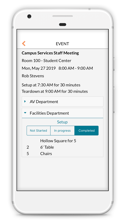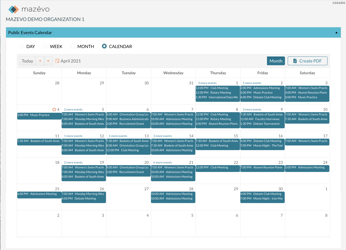The rarest beast in the scheduling forest is that event where you get all of the information upfront and none of the details change on the way to (and through) the execution of a successful gathering. If you’re fortunate enough to spot one of those, you should frame the event confirmation!
Most events continue to evolve from the time the customer first reaches out to the scheduling department to the moment the event gets underway—or beyond. Who hasn’t been contacted by a panicked event host who forgot some critical detail and needs you to address it on-the-fly as they return to their guests?
So, changes to event details are unavoidable. But the resulting stress can be avoided if you approach changes the right way.
Best Practices for Handling Event Changes Efficiently
The three keys to taking event changes in stride are:
- Easily knowing whether you can accommodate the change
- Making sure the appropriate team members know about the change
- Having a way to manage changes efficiently so you spend as little time on them as possible
How can you reach those goals? By following the proven best practices below:
- Train your staff on what resources and services you can and can't provide. You don’t want to say “Yes” to a request you can’t accommodate or “No” to one you can.
- Enabler team members who work with customers to review change requests easily. The simpler it is to access change requests, the easier it is to review them, determine if they’re feasible, and respond to the customer promptly.
- Use your online request form as a “gatekeeper.” Notify customers about how much lead time is needed to make change requests online using your form. For example, your policy might be that any changes requested within seven days of an event have to be made by contacting a staff member directly. This helps keep last-minute requests from slipping through the cracks and also forces customers to really consider how important a change is. It’s easy to make a request mere hours before an event if all you have to do is submit a form. If you’ve got to talk with someone about it, that can be a little uncomfortable—and in this case, a customer’s discomfort is a good thing!
- Consider charging a fee for last-minute changes to encourage customers to plan ahead. Even a small amount can be a big incentive.
- Require that your team enter all changes into the scheduling system. Your system should be your "one source of truth" about events. Sticky notes about a change stuck to a person’s computer monitor aren’t available to other team members—now or down the road when there’s a reason to look back at the sequence of events related to a change. This information can be invaluable if there are disagreements about an event, which is why Mazévo keeps a log of all changes to an event and also allows users to review changes across all events for a period of time in the Activity Log.

- Have an efficient way to communicate changes to staff members. It has to be easy to contact the people providing the affected services or it won’t get done—especially when someone receives a change request when they’re busy or distracted.
- Consider the true scope of a change before agreeing to it. For example, it might seem at a glance that moving an event from Conference Room A to Conference Room B is easy. But when you look a little more closely at the event details, you see that the event calls for some built-in A/V equipment that’s available in A but not in B. That means you’ve got to see if portable equipment is available, confirm that the smaller portable unit will still meet the user’s requirements, etc. A reflexive “Yes” can get you into trouble.
- Have a standardized process in place for reviewing upcoming events. Decide when and how it’s most effective to review events and do it that way every time. Many organizations review bookings 7-14 days out from the event date to ensure all the details have been attended to. There still may be change requests after that point, but at least you’re in good shape heading into the homestretch.
- Ensure that your event management system highlights changes. For example, Mazévo's review function notes any updates since the last time you looked at an event.
Understanding “Push” and “Pull” Information Access
Most people are familiar with push notifications—things like alerts from a social media platform you’re on. Some event management systems operate by the same principle regarding changes. Every time a modification is made to any event detail, people get an email from the system. While that might seem convenient, there are some disadvantages to that approach.
For one thing, it encourages a change-management-by-inbox mentality, and it’s too easy to lose track of important information in an email system. It’s also difficult to get the context surrounding a change request, since you can’t see all of the pertinent information in an email. Too often, changes get made that cause other issues with an event that go unnoticed.
In addition, after looking at an email that has information on a change to event details, you probably still need to access reports or other information from your event management system. Now you’re using two systems to address a change—even a simple one.
Pulling change information from your event management solution is a better approach for multiple reasons, including that this approach:
- Reduces the amount of email generated and makes everyone’s inbox less cluttered
- Enables service providers to see all the details of an event that has changed, along with information on other events happening that day that they need to be working on
- Enables you to manage changes using one system rather than two
- Ensures that the information you’re looking at is accurate as of the moment you pull it up, as opposed to an old email that may or may not have accurate information
At Mazévo, it’s been our experience that the intentionality of pulling information from the system leads to the best results. That’s why our scheduling solution is designed that way.
We support that approach in multiple ways, including:
- Our solution isn’t priced according to user licenses, which means you can give system access to anyone who needs it without paying more.
- Reports can be published to a URL that you can share with service providers. When they need information, they simply run the report to see up-to-the-minute details. They don’t even have to log in. Other systems typically email reports to providers—generally once a day. And very quickly the information in those reports can be outdated.
- The Mazévo app enables users to get real-time information when they’re on
 -the-go. If an event was changed two minutes ago, you’ll see the change when you access the app now. Users can also check off tasks in the app and log additional information about a completed event—like damage they see to a room or equipment, for example—including pictures if appropriate.
-the-go. If an event was changed two minutes ago, you’ll see the change when you access the app now. Users can also check off tasks in the app and log additional information about a completed event—like damage they see to a room or equipment, for example—including pictures if appropriate.
Managing Event Changes: Processes and Technology Are Key
Ultimately, if you have the right processes and technology in place, managing changes—even last-minute changes—is a breeze. How could Mazévo make your job easier? Get a live demo customized to your challenges to find out. Contact us at 800-254-7615 or schedule your session online.



